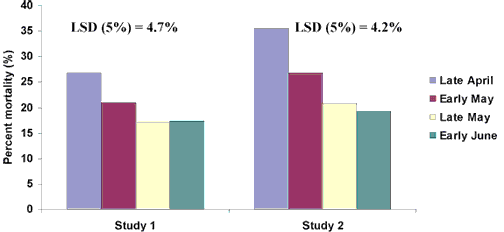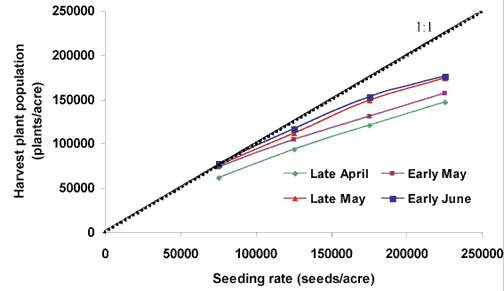Ames, Iowa
April 9, 2007
Source:
Integrated Crop
Management
by Palle Pedersen and Jason De Bruin
Department of Agronomy, Iowa
State University
This article originally
appeared on
pages 107-108 of the IC-498 (5) -- April 9, 2007 issue.
In last week's article,
Soybean seeding rates: The balance between
cost and yield, the case was made that 100,000 plants per
acre at harvest was sufficient to reach both full yield
potential and economic return. An important question that is
often asked is, "how many seeds need to be planted to attain
this final stand at harvest?" In a perfect world, the
relationship would be 1:1, indicating that every seed planted
would correspond to a plant at harvest. We all know this is not
the case. Since 2003, Iowa State University Extension
researchers have conducted more than two dozen experiments with
the checkoff and the Iowa Soybean Association at multiple
locations across Iowa.
In extension studies, seeding rates used are typically between
75,000 and 225,000 seeds per acre. Planting 225,000 seeds per
acre is not cost effective. Planting 75,000 seeds per acre is
too risky and will often not give the maximum attainable yield.
Row spacing
Plant mortality (% reduction in
harvest population compared to seeding rate) was 9.1 percent
greater in 30" rows compared to 15" rows averaged across four
seeding rates. When the seeding rate was 125,000 seeds per acre
the final populations were 108,000 and 96,000 plants per acre at
harvest for 15" and 30" rows, respectively. Planting 175,000
seeds per acre increased final plant populations equally but did
not increase yield.
Planting date
When planting the last week of
April, mortality was 25 to 35 percent and decreased 10 to 15
percent by planting in early June (Figure 1). Data collected
from six locations consistently showed that planting 125,000
seeds per acre the last week of April gave a final stand of
93,000 plants per acre at harvest. Planting 175,000 seeds per
acre increased final stand to 124,000 plants per acre. Based on
Figure 2, seeding 140,000 seeds per acre the last week of April
would give a final stand of 100,000 plants per acre at harvest.
Planting 125,000 seeds per acre the first week of May was enough
to achieve a final stand of 100,000 plants per acre. There are
"worst case scenarios" that are difficult to prepare for. Early
planting into a tilled seed bed, followed by hard rainfall, can
cause soil crusting. Reduced seeding rates can be risky and
knowledge of field conditions and previous history should be
taken into account to minimize the potential for reduced plant
establishment. This is especially the case when you want to
increase yield potential by early planting.
 |
| Figure
1. Percent mortality for four seeding rates planted
between late April and early June averaged across Ames,
Crawfordsville, and Nashua in Study 1 and DeWitt,
Nevada, and Whiting in Study 2. |
 |
|
Relationship between seeding rate and harvest plant
population four planting dates for a study conducted
at DeWitt, Nevada, and Whiting between 2004 and 2006
in 15-inch row spacing. |
Seed treatment
Adding a fungicide or fungicide/insecticide seed treatment can
be used to increase plant establishment. Iowa State University
Extension has conducted research at five locations for three
years and, on average, use of a fungicide seed treatment
improved plant establishment by 8,000 plants per acre and 17,000
plants per acre using a fungicide/insecticide seed treatment.
Variety
Many different varieties have been evaluated. There is a
wide range in plant establishment for these varieties but no
characteristic common to the varieties with poor establishment.
Purchasing high-quality seed will help a lot.
Other considerations
In order to reduce seeding rates and still achieve 100,000
plants per acre at harvest, equipment setting, residue
management, planting depth, and planting speed are more
important than anything else. Seedbed conditions are a critical
component as well. Plant early but only when seedbed conditions
are adequate. Poor field conditions will reduce emergence and
increase gaps in the stand, potentially reducing yield. No data
are available for no-tillage; beginning this year, a new study
will determine seeding rate recommendations in a no-tillage
system. Based on previous reports, mortality is greater under
no-tillage conditions.The recommendation is to seed between
125,000 and 140,000 seeds per acre, regardless of row spacing,
planting date, or seed treatment. However, it is important that
you recognize that it will vary from year to year, field to
field, and farmer to farmer. Start to reduce your seeding rate
on just a few acres this year. You are the only one who will
know how low you can go on your farm to achieve an even stand of
100,000 plants per acre at harvest.
Palle Pedersen is an assistant professor of agronomy with
research and extension responsibilities in soybean production.
Jason De Bruin is an assistant scientist with research
responsibilities in soybean production.
This article originally appeared on
pages 107-108 of the IC-498 (5) -- April 9, 2007 issue. |
|